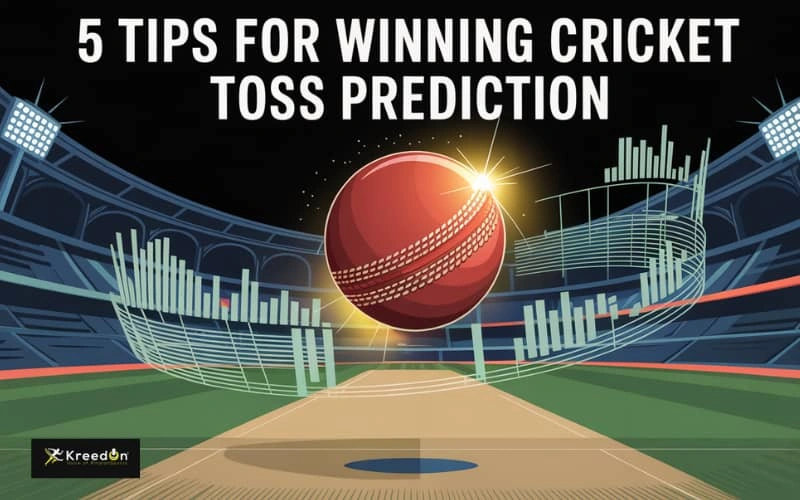Cricket toss prediction is a critical element in the game of cricket. Whether you are a seasoned bettor or a casual fan, understanding how to predict the outcome of the toss can help you make more informed decisions. Winning a toss can have a significant impact on the match kreedon, as it determines the choice of whether a team will bat or bowl first. While the outcome of a toss is ultimately random, there are several tips and strategies you can follow to increase your chances of making accurate predictions. Below are five tips that can help improve your cricket toss prediction game.
1. Understanding the Importance of the Toss
The first step in making an informed cricket toss prediction is to understand the significance of the toss. The toss is not just a random event; it plays a crucial role in determining the team’s strategy for the match. In many cricket matches, the team that wins the toss is at a significant advantage because they can choose to either bat or bowl based on the prevailing conditions.
In general, teams prefer to bowl first in conditions where the pitch is expected to deteriorate as the match progresses. This is particularly true for test matches where the weather, pitch conditions, and other factors can change significantly over five days. On the other hand, teams may opt to bat first in conditions where the pitch is expected to be flat and conducive to high-scoring games, such as in limited-overs matches or when the weather forecast indicates that rain might interrupt play later on.
By keeping track of these preferences and understanding how different teams approach the toss in various conditions, you can increase your chances of making an accurate toss prediction. It’s also important to consider factors such as the team’s recent performance and overall strategy, as these can influence the captain’s decision once they win the toss.
2. Analyzing Weather Conditions
Weather plays a significant role in cricket, especially when it comes to toss predictions. Weather patterns, such as humidity, wind, and temperature, can influence the pitch conditions and affect the team’s decision at the toss. For example, a wet or humid day could lead to a more favorable bowling attack in the early stages of the match, which could influence the captain’s choice. On the other hand, a hot and dry day could favor batting conditions.
In some regions, like the subcontinent, dew can also become a crucial factor in the game. As the day progresses, the presence of dew on the field can make it difficult for bowlers, especially spinners, to grip the ball. Therefore, teams may opt to bowl first to take advantage of the drier conditions early in the match.
Monitoring weather forecasts and understanding how they affect the match’s playing conditions can give you an edge when making your cricket toss prediction. Make sure to stay updated with the weather conditions leading up to the toss, as they can shift rapidly and impact the captain’s decision.

3. Studying Pitch Conditions
The pitch is one of the most critical factors in any cricket match, and its condition can greatly influence the outcome of the toss. Different pitches offer different advantages, depending on factors like the type of surface, moisture content, and wear and tear from previous games. Typically, a dry pitch will favor batting, while a pitch that has moisture or grass cover will assist the bowlers, particularly in the early stages of the match.
Understanding how a pitch behaves over time is key to making accurate toss predictions. For example, in some stadiums, the pitch may start off with more bounce and swing, favoring bowlers, and then become easier for batting as the game progresses. In other cases, the pitch may break down or turn, creating Cricket Toss Prediction a more favorable environment for spinners. A good grasp of these conditions can help you predict whether the winning captain will choose to bat or bowl first.
It’s also worth noting that some teams have preferences based on the pitch conditions. Some teams perform better on dry, turning pitches, while others might prefer pitches that offer assistance to pace bowlers. Analyzing the pitch history of a stadium can give you a more in-depth understanding of how teams generally approach toss decisions in those conditions.
4. Team Form and Past Toss Decisions
Past performance is a good indicator of future actions, and this principle applies to cricket toss predictions as well. By Cricket Toss Prediction looking at a team’s recent form, you can gain insights into how they might approach the toss. For instance, a team that has been in good form with their batting may prefer to bowl first to put pressure on their opponents. Conversely, a team that has been consistently good at chasing totals might prefer to bowl first if they believe they can control the target better.
Additionally, many teams have a record of winning the toss in specific conditions or formats. Analyzing these trends can give you valuable information when making your toss prediction. If a team has a strong record of winning the toss and choosing to bowl first on similar pitches, it is more likely that they will make that decision again, provided the conditions are similar.
Another aspect to consider is the influence of captaincy. Some captains are more aggressive in their approach, while others may prefer a conservative strategy. A captain who is known for taking bold decisions at the toss, such as opting to bowl first in difficult conditions, could be more likely to do so again in future matches.
5. Monitoring Toss Statistics
One of the simplest but most effective strategies for making accurate cricket toss predictions is to keep track of toss statistics. Many cricket experts and analysts provide detailed statistics on how often teams win the toss, and whether they choose to bat or bowl first. These statistics can give you a more precise Cricket Toss Prediction understanding of the likelihood of a team making a particular decision.
For example, if you observe that a particular team has won the toss multiple times and opted to bowl first, you can factor this information into your prediction. Toss statistics can also reveal trends in different conditions and venues, which can help you fine-tune your predictions for specific games. By regularly reviewing toss data, you can gain insights into the patterns that often precede a team’s decision.
These toss statistics can also be combined with other predictive models, such as those based on weather Cricket Toss Prediction and pitch conditions, to give you a more holistic understanding of how likely a team is to win the toss and make a specific decision.
Conclusion
While cricket toss prediction is never an exact science, there are several strategies that can help you increase your Cricket Toss Prediction chances of making an informed guess. By understanding the importance of the toss, analyzing weather conditions, studying pitch behavior, considering team form, and monitoring toss statistics, you can improve your prediction accuracy. Toss predictions are a fun and engaging aspect of the game, and with the right knowledge









